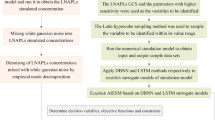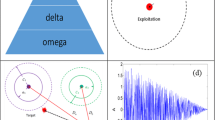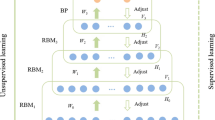Abstract
Groundwater remediation design is crucial to contemporary water resources management, which is prone to massive computational costs due to the complexity and nonlinearity of the groundwater system. Traditional surrogate methods that can reduce the computational costs tend to encounter barriers of scalability and accuracy when the input–output relationship is highly nonlinear or high-dimensional. To tackle these problems, we herein propose a novel simulation–optimization method that embeds the deep learning deep belief network (DBN) into the particle swarm optimization (PSO) algorithm for groundwater remediation design. Firstly, a numerical simulation model based on MODFLOW and MT3DMS is established to describe the impact on the pollution environmental fate of various implementations of the remediation strategy. The input dataset to train DBN is comprised of various remediation strategies that evolve automatically in the PSO iterations, and the corresponding output dataset constituted of contaminant concentration at observation wells is garnered by executing the simulation model. In the optimization process, the DBN is retrained in an adaptive pattern to enhance prediction accuracy, selectively substituting for the original simulation model to alleviate the computational burden. Additionally, the PSO algorithm undergoes discretization and collision averting within each individual to adapt to the specific remediation task. The results reveal that the proposed method manifests satisfactory convergence behaviour and accuracy, capable of unburdening a considerable proportion (68.8%) of the time consumption for optimal groundwater remediation design.







Similar content being viewed by others
Availability of Data and Materials
Will be provided on request.
References
Alkizwini RS (2021) The use of an organo-kaolinite sorbent in a permeable reactive barrier for remediating groundwater contaminated with methylene blue dye: experimental and theoretical investigation. Environ Process 8(2):889–910. https://doi.org/10.1007/s40710-021-00515-1
Bai Y, Chen Z, Xie J, Li C (2016) Daily reservoir inflow forecasting using multiscale deep feature learning with hybrid models. J Hydrol 532:193–206. https://doi.org/10.1016/j.jhydrol.2015.11.011
Chen Y, Liu G, Huang X, Chen K, Hou J, Zhou J (2021) Development of a surrogate method of groundwater modeling using gated recurrent unit to improve the efficiency of parameter auto-calibration and global sensitivity analysis. J Hydrol 598:125726. https://doi.org/10.1016/j.jhydrol.2020.125726
Cho K, Ilin A, Raiko T (2011) Improved learning of gaussian-bernoulli restricted boltzmann machines. Paper presented at the 21st International Conference on Artificial Neural Networks, ICANN 2011, Berlin, Heidelberg
Dagasan Y, Juda P, Renard P (2020) Using generative adversarial networks as a fast forward operator for hydrogeological inverse problems. Groundwater 58(6):938–950. https://doi.org/10.1111/gwat.13005
Hinton GE (2002) Training products of experts by minimizing contrastive divergence. Neural Comput 14(8):1771–1800. https://doi.org/10.1162/089976602760128018
Hinton GE, Osindero S, Teh Y (2006) A fast learning algorithm for deep belief nets. Neural Comput 18(7):1527–1554. https://doi.org/10.1162/neco.2006.18.7.1527
Hinton GE, Salakhutdinov RR (2006) Reducing the dimensionality of data with neural networks. Science 313(5786):504–507. https://doi.org/10.1126/science.1127647
Janža M (2022) Optimization of well field management to mitigate groundwater contamination using a simulation model and evolutionary algorithm. Sci Total Environ 807:150811. https://doi.org/10.1016/j.scitotenv.2021.150811
Kennedy J, Eberhart R (1995) Particle swarm optimization. Paper presented at the 1995 IEEE International Conference on Neural Networks (ICNN 95), Perth, Australia
Li J, Lu W, Luo J (2021) Groundwater contamination sources identification based on the Long-Short Term Memory network. J Hydrol 601:126670. https://doi.org/10.1016/j.jhydrol.2021.126670
Lykkegaard MB, Dodwell TJ, Moxey D (2021) Accelerating uncertainty quantification of groundwater flow modelling using a deep neural network proxy. Comput Methods Appl Mech Eng 383:113895. https://doi.org/10.1016/j.cma.2021.113895
Majumder P, Eldho TI (2020) Artificial neural network and grey wolf optimizer based surrogate simulation-optimization model for groundwater remediation. Water Resour Manage 34(2):763–783. https://doi.org/10.1007/s11269-019-02472-9
Marçais J, de Dreuzy J (2017) Prospective interest of deep learning for hydrological inference. Groundwater 55(5):688–692. https://doi.org/10.1111/gwat.12557
Miao T, Guo J (2021) Application of artificial intelligence deep learning in numerical simulation of seawater intrusion. Environ Sci Pollut Res 28(38):54096–54104. https://doi.org/10.1007/s11356-021-13680-5
Mohanadhas B, Kumar GS (2019) Numerical Experiments on Fate and Transport of Benzene with Biological Clogging in Vadoze Zone. Environ Prog 6(4):841–858. https://doi.org/10.1007/s40710-019-00402-w
Pan Z, Lu W, Fan Y, Li J (2021) Identification of groundwater contamination sources and hydraulic parameters based on bayesian regularization deep neural network. Environ Sci Pollut Res 28(13):16867–16879. https://doi.org/10.1007/s11356-020-11614-1
Razavi S, Tolson BA, Burn DH (2012) Review of surrogate modeling in water resources. Water Resour Res 48(7). https://doi.org/10.1029/2011WR011527
Rezaei H, Bozorg-Haddad O, Loáiciga HA (2020) Reliability-based multi-objective optimization of groundwater remediation. Water Resour Manage 34(10):3079–3097. https://doi.org/10.1007/s11269-020-02573-w
Sadeghfam S, Hassanzadeh Y, Khatibi R, Nadiri AA, Moazamnia M (2019) Groundwater remediation through pump-treat-inject technology using optimum control by artificial intelligence (OCAI). Water Resour Manage 33(3):1123–1145. https://doi.org/10.1007/s11269-018-2171-6
Shams R, Alimohammadi S, Yazdi J (2021) Optimized stacking, a new method for constructing ensemble surrogate models applied to DNAPL-contaminated aquifer remediation. J Contam Hydrol 243:103914. https://doi.org/10.1016/j.jconhyd.2021.103914
Shen C (2018) A Transdisciplinary review of deep learning research and its relevance for water resources scientists. Water Resour Res 54(11):8558–8593. https://doi.org/10.1029/2018WR022643
Yan S, Minsker B (2006) Optimal groundwater remediation design using an Adaptive Neural Network Genetic Algorithm. Water Resour Res 42(5). https://doi.org/10.1029/2005WR004303
Zhang S, Qiang J, Liu H, Zhu X, Lv H (2022) A construction strategy for conservative adaptive Kriging surrogate model with application in the optimal design of contaminated groundwater extraction-treatment. Environ Sci Pollut Res. https://doi.org/10.1007/s11356-021-18216-5
Zhao Y, Qu R, Xing Z, Lu W (2020) Identifying groundwater contaminant sources based on a KELM surrogate model together with four heuristic optimization algorithms. Adv Water Resour 138:103540. https://doi.org/10.1016/j.advwatres.2020.103540
Funding
None.
Author information
Authors and Affiliations
Contributions
All authors contributed to the study conception and design. Material preparation, data collection were performed by Yuchuan Meng and Xiaohua Huang. Data analysis was performed by Yu Chen and Guodong Liu. The first draft of the manuscript was written by Yu Chen and all authors commented on previous versions of the manuscript. All authors read and approved the final manuscript.
Corresponding author
Ethics declarations
Ethical Approval
Not applicable.
Consent to Participate
The authors declare that they consent to participate.
Consent to Publish
The authors declare that they consent to publish.
Competing Interests
None.
Additional information
Publisher's Note
Springer Nature remains neutral with regard to jurisdictional claims in published maps and institutional affiliations.
Supplementary Information
Below is the link to the electronic supplementary material.
Rights and permissions
About this article
Cite this article
Chen, Y., Liu, G., Huang, X. et al. Groundwater Remediation Design Underpinned By Coupling Evolution Algorithm With Deep Belief Network Surrogate. Water Resour Manage 36, 2223–2239 (2022). https://doi.org/10.1007/s11269-022-03137-w
Received:
Accepted:
Published:
Issue Date:
DOI: https://doi.org/10.1007/s11269-022-03137-w




